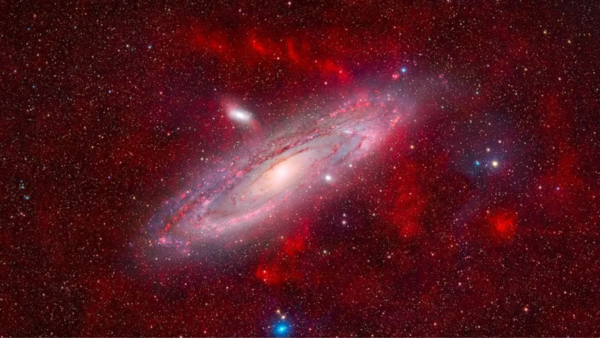
On a quiet hilltop in Portugal, beneath one of Europe’s darkest skies, a photographer has captured more than just a galaxy. He’s captured a dream, five years in the making.
Miguel Claroa renowned astrophotographer and science communicator based in Lisbon, has unveiled his latest cosmic masterpiece: a breathtaking deep-space portrait of the Andromeda Galaxy (M31), surrounded by wisps of glowing red gas and a sea of stars. Taken from the Dark Sky Alqueva Observatory in Cumeada, this image isn’t just a scientific feat, it’s a deeply personal journey through time, space, and passion.
Started in 2020, achieved in 2025 — A dream that took five years
Claro first attempted to photograph Andromeda enveloped in faint hydrogen clouds back in 2020, using a DSLR camera. “That image stayed with me,” he reflects. “It whispered that there was more to be seen, more to be told.”
Inspired by recent scientific discoveries, including a newly identified oxygen-III (OIII) emission arc near Andromeda, Claro returned to the galaxy. This time, he came with new equipment, refined skills, and a vision shaped by years of experience.
How do he photograph light invisible to the naked eye
He spent 80 hours collecting light from the heavens, using a special dual-band filter to detect Ha and OIII emissions, ionised gases invisible to the naked eye. His goal was ambitious: to reveal not only Andromeda’s famous spiral structure but also the delicate veil of glowing hydrogen gas surrounding it, and perhaps even the elusive OIII arc.
Though the arc proved too faint for his current setup, the image still offers a profound glimpse into the galaxy’s environment. OIII signals reveal potential planetary nebulae hidden within its arms. The result is a hauntingly beautiful celestial scene, a swirling galactic city glowing softly amidst clouds of cosmic mist, framed by stars of every colour.

Image Credits: Miguel Claro
What makes this image more than just a scientific achievement
What makes this project resonate isn’t just the astronomical achievement, but the emotional undertone. “This image is my way of connecting Earth and sky,” Claro says. “Of showing that beauty exists far beyond our planet, and yet, it’s deeply human to want to reach for it.”
Claro’s photograph, now available as fine art prints, is more than wall decor. It’s a conversation starter, a reminder of the mysteries above, and a tribute to perseverance. Through trials, technical challenges, and long nights under cold skies, he has managed to turn scientific data into something poetic.
His work not only bridges the gap between art and science, but also brings the cosmos a little closer to those of us who spend our nights looking up in wonder. “I hope when people look at this image, they feel part of something vast and beautiful,” he says. “Because we are.”








